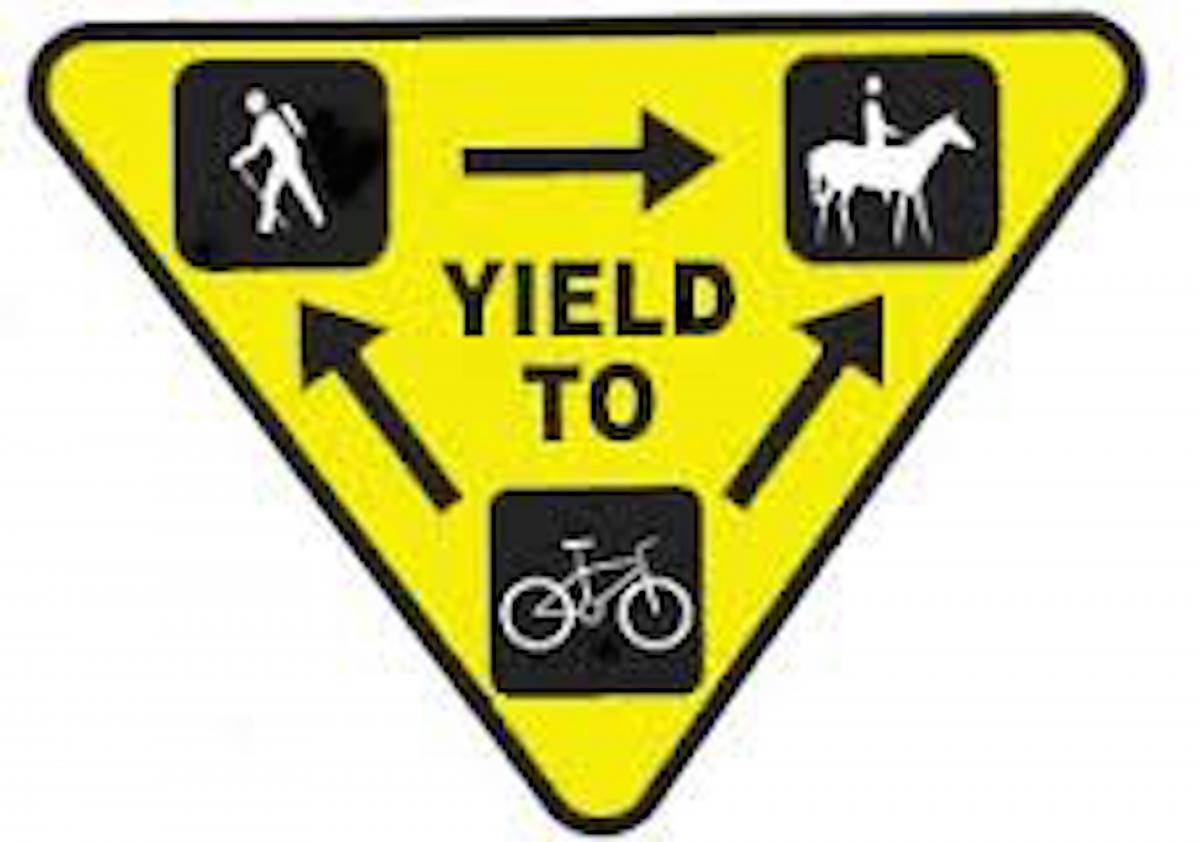Multi-Users>Stop, Stand, and Speak

“We were having such a great ride until I got dumped! We were cantering home and we came around a corner and some guy was crouched in the middle of the trail taking a picture. Bugsy spooked, I flew off and landed on my back on a log.” Marietta Madden– A Friend from Boulder Creek, Riding in the Redwoods 4/15/2018
Many trails have multiple user groups from hikers, mountain bikers, dirt bikers, hunters, fishermen, and horses may all encounter each other at any given time. We support multi-use of our trails, there is a synergy when we all come together to use, maintain, and protect the trails. We all are out there because we all love the outdoors even though we may choose to enjoy the trails in different ways. We all have different weaknesses and strengths. But everyone on the trail loses if an encounter with a horse and rider ends with the horse going into fight or flight response; the rider may be thrown, the horse may fall, and the person(s) on a bike or on foot could get trampled, kicked, or bitten, serious injury or death may occur for one or all. So for your protection, the protection of the horse and rider; Stop, Stand, and Speak. It is proper etiquette to yield to horse and rider if you are hiking or biking. The horse is a sentient being that must trust that you intend no harm. The horse may be 1000 pounds or more that through evolution has both the tools to defend itself or flee.
A horse is a prey animal and it’s in its DNA, is hardwired for fight or flight if it thinks you are a predator; you look, act, and smell like a predator; in fact, you are one. However, through conditioning and training, horses have learned that MOST people are not a threat. It is your job to assure the horse you are not a threat.
Horses do not see the way you and I do they do not process images the way you and I do, sight is not their primary sense; hearing and smell are. If you are directly in front of them they may not see you or do not see enough of you to process what you are. Like the side mirrors on a truck they have a blind spot behind them but close in front as well. If you have a backpack with the sleeping bag above your head the horse may see your silhouette and movement as a bear. A fishing pole, firearm, or anything else that is straight up above your head, be it strapped to your back, backpack, or in your hands, it sees as aggressive behavior by the bear. If you are on a bicycle your silhouette and movement mimic that of a mountain lion. Either way the horse may try to turn and run and fall from the trail or bridge (bridges are already stressful for horses they had to be trained to overcome their fear of the bridge and you just might put them over the top), put rider or self into a tree, or the horse might try to fight you with a battering ram head, teeth, and flying hooves. If the horse rears back to pound you with his front hooves it may throw the rider and may fall backward crushing the rider. If it is a new rider the rider by instinct may grip the horse with legs to hang on, which tells the horse to run, if the rider pulls on the reins to get the horse to stop that combination of run and stop will make the horse rear up. So what can you do? Easy, step off the trail, (a horse can see you better from the side) stop, if you have a fishing rod, rifle, walking stick, point it to the ground and stand this will all reduce the horse seeing you as aggressive. However, if you are silent the horse may not yet recognize you as a friendly person but as a stocking predator. Also be aware that if the rider is alone may also have fear of you. Horses are intuitive and key into the confidence, fear, or aggression from its rider. So speak in friendly terms and voice. Do not reach to touch the horse in any way just give them space. Many lady riders have learned that someone reaching to pet the head of their horse is trying to grab the bridle to control the horse or approaching the side of the horse trying to grab the leg of the rider to pull them from the horse. Many have learned to use their horses to defend themselves from someone on the ground. So again step to the side, give the rider and horse space, stand still and in a friendly voice say, “Nice day for a ride.”
The horse and rider can now put all the pieces together that you a friendly human, someone that they can learn to trust. The situation that prompted the quote at the beginning of this article after being taken to the ER and having a CT scan she in fact broke her back. She’s in a great deal of pain and will be out of work for 4 - 6 weeks. We wish her a speedy recovery.
So the next time you are on the trail and you meet a horse, Stop and stand, then in a calm and friendly voice say, “Hello, nice day for a ride.” And you will get back a nice friendly, “It is, thank you,” and everyone will continue to have a great adventure.